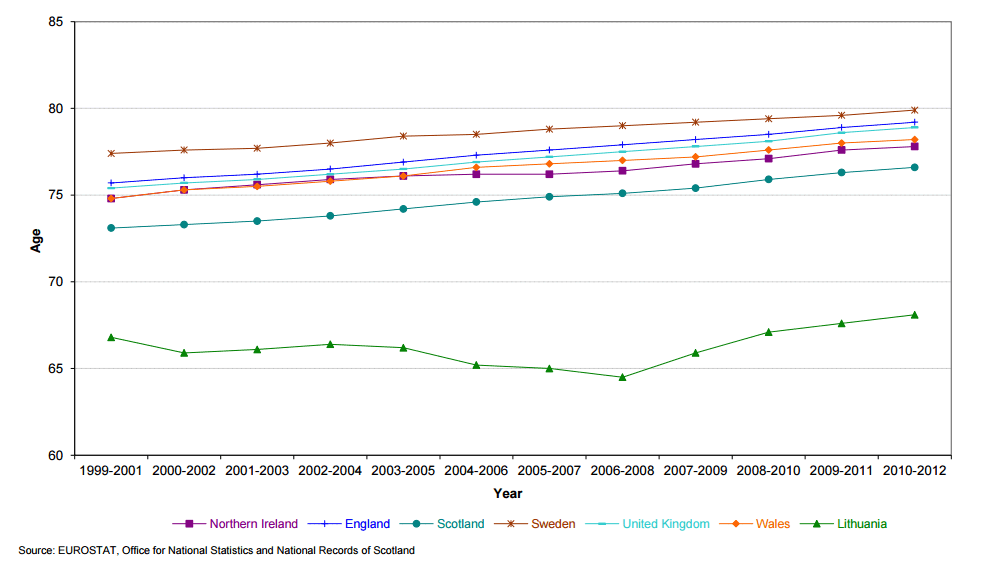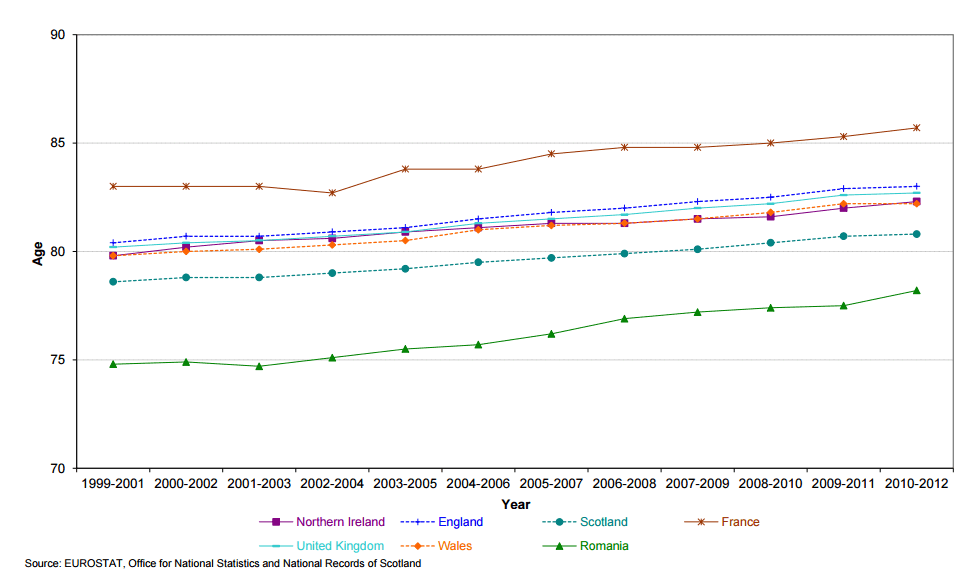3.1 Figure 1 shows that the expectation of life at birth in Scotland has shown constant improvement over the last 29 years. It has increased from 69.3 years for males born in the period 1981-1983 to 76.6 years for those born in 2010-2012, an increase of 7.3 years. For females, life expectancy has increased from 75.5 years for those born in the period 1981-1983 to 80.8 years for those born in 2010-2012, an increase of 5.3 years.

3.2 Figure 1 also shows that the gap between male and female life expectancy at birth has decreased from 6.2 years in 1981-1983 to 4.2 years in 2010-2012. Male life expectancy has been increasing at a faster rate than for females since 2001-2003.
3.3 The improvement in life expectancy at birth for males and females in Scotland since 1999-2001 can be seen in Figure 2a (males) and Figure 2b (females). Comparisons are also given with life expectancy in the United Kingdom, countries within the UK and the countries that typically have the highest and lowest life expectancy in the European Union (EU) (Sweden and Lithuania for males and France and Romania for females).
3.4 Although male and female life expectancy continues to increase in Scotland, it is still below the UK average, which is 78.9 years for males and 82.7 years for females. The gap between UK and Scottish life expectancy is now wider than in 1999-2001, by 0.3 years for females. For males the gap has remained constant.


3.5 Scottish male life expectancy has been consistently lower than that of males in England, Northern Ireland and Wales, although the gap has varied over time. Males in England, Wales and Northern Ireland can expect to live longer than those in Scotland by 2.6 years, 1.6 years and 1.2 years respectively. In comparison to 1999-2001, the gap with England has remained constant and the gap with Wales has narrowed by 0.1 years. The gap with Northern Ireland has also narrowed, by 0.5 years.
3.6 The pattern is similar for female life expectancy in Scotland. Females in Scotland can expect to live 2.2 years fewer than females in England, 1.4 years fewer than females in Wales and 1.5 years fewer than females in Northern Ireland. Over time, the gap has widened by 0.4 years compared with England, by 0.3 years compared with Northern Ireland and by 0.2 years compared with Wales.
3.7 Male life expectancy in Sweden at 79.9 years is the highest among the EU’s 28 member states, 3.3 years higher than in Scotland. In Lithuania, male life expectancy is 68.1 years, the lowest in the EU and 8.5 years lower than in Scotland. Since 1999-2001 male life expectancy has improved, reducing the gap with Sweden and increasing the gap with Lithuania.
3.8 France has the highest female life expectancy in the EU at 85.7 years, 4.9 years higher than in Scotland. In Romania female life expectancy is 78.2 years, one of the lowest in the EU. Female life expectancy in Scotland has not improved as much as in France or Romania. The gap in life expectancy between French and Scottish women is 0.5 years wider than in 1999-2001 and the gap between Scottish and Romanian women is 1.2 years narrower than in 1999-2001.
Footnote: